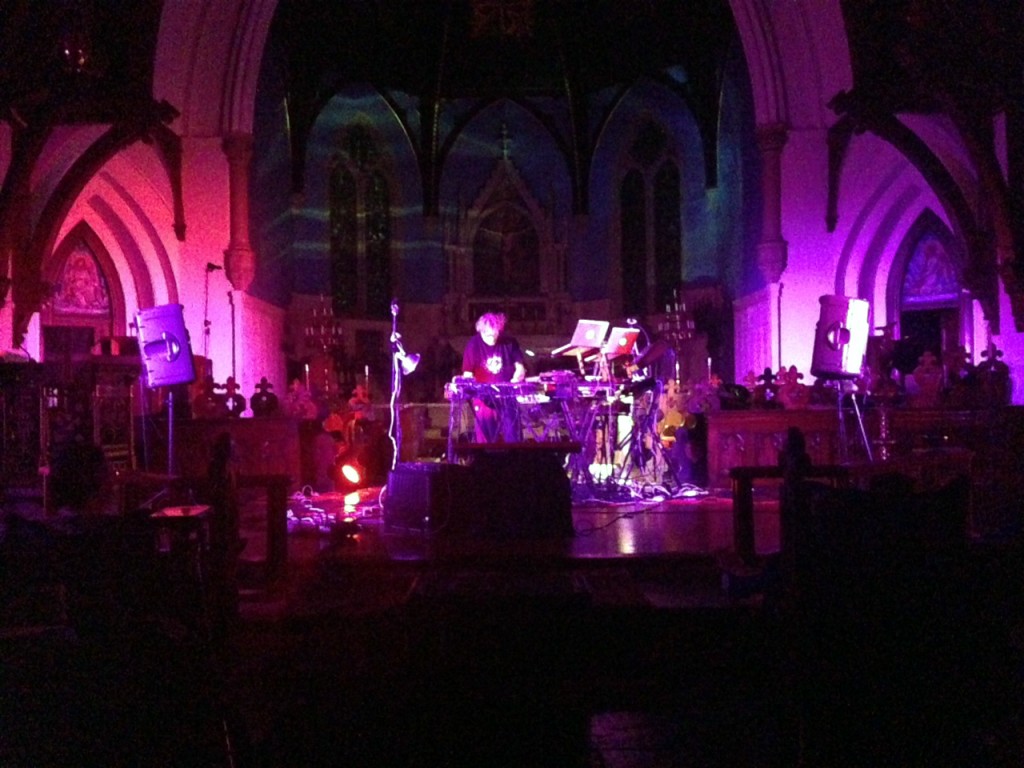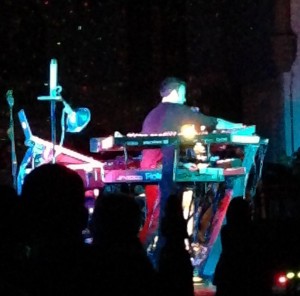Steve Roach Brings Down the Heavens
 Steve Roach closed his more than two hour performance on Saturday night at The Gatherings Concert Series with an unceremoniously truncated “Structures from Silence,” one of his signature works. In newspaper terms, that’s called burying the lead, which Roach did in this expansive concert that found the highly regarded electronic musician taking a sold out crowd into largely uncharted terrain.
Steve Roach closed his more than two hour performance on Saturday night at The Gatherings Concert Series with an unceremoniously truncated “Structures from Silence,” one of his signature works. In newspaper terms, that’s called burying the lead, which Roach did in this expansive concert that found the highly regarded electronic musician taking a sold out crowd into largely uncharted terrain.
Steve Roach is a musician who paints in panoramas. Textures and pulses are his palette with little in the way of conventional melody or rhythm. And although he was surrounded by several electronic keyboards, his music has little to do with keyboards at all.
Having said that, Roach did open his concert planted front of altar, behind a lone, Nord Lead synthesizer, drawing out long, luminous drones that played out into twilight space. This served as an alap that drifted into deeper textures as Roach moved into his electronic cockpit, summoning up synthesizer growls, cosmic string swells and distressed textures. As the piece traveled on, fuzz tone horns brayed a clarion call as if signaling the last charge of a Viking tribe.
 Those expecting the intricate analog sequencer dervish of his recent album, Skeleton Keys or the tribal moods of his 1990s work would be disappointed. Roach left his monster modular system and didgeridoo home and instead came with a collection of digital keyboards, mixers and computers, the latter of which was the main instrument of this show as programmed sequences, sounds, textures and percussion rolled out.
Those expecting the intricate analog sequencer dervish of his recent album, Skeleton Keys or the tribal moods of his 1990s work would be disappointed. Roach left his monster modular system and didgeridoo home and instead came with a collection of digital keyboards, mixers and computers, the latter of which was the main instrument of this show as programmed sequences, sounds, textures and percussion rolled out.
After what turned out to be a long prelude, the more recent 21st century Roach sound emerged chirping sequencers rising through filter sweeps and manic hi-hats slid in brush-stroked frenzy. His movements ascended to sometimes scary peaks before dissolving into the faintest of whispers of barely there wind-swept expanses and voices sitting at the edge of comprehension.
Out of the near silence, a jungle awakened to the dawn, chirping electronic creatures sending out semaphore signals in a fog shrouded valley. As a-rhythmic and a-melodic tension builds the drums of doom emerge like storm troopers on steroids, big thunderous claps of percussion dancing to voodoo machine music.
Even with tribal percussion, Roach never hit anything that might be considered a groove. Instead, over the course of 2 plus hours, he ebbed and flowed on usually beatless shores. Space probe melodies emerged amidst sweeping strings; a chrome-plated piano sounded like Conlon Nancarrow in a trance. Finally, 2 hours in, Roach brought out a classic Berlin-school sequencer groove that dissolved into more sonic abstractions and just as you thought it was ending, he segued into another section.
Steve Roach is a musician who never met a period. There were several times where it felt like he’d reached a satisfying conclusion, only to move into another section. His set was supposed to be 90 minutes long but it cascaded over 2 hours. I’m not sure if he was going to actually play “Structures from Silence,” or just leave it as a fragmentary commentary on his legacy. If he had played it, “Structures” would’ve added another 30 minutes to the set, but after a few of the opening chords, he was given the hook by The Gatherings organizer Chuck Van Zyl who was facing venue time constraints.
Steve Roach has evolved considerably since his early sequencer days. He really shouldn’t be considered a New Age or Space musician at all anymore. Roach is an avant-garde artist working in sonic textures closer to Karlheinz Stockhausen’s ‘Aus Den Sieben Tagen” than anything Tangerine Dream or Klaus Schulze ever purveyed. His is the art of the studio taken to extremes, which is why I find his concerts a little disappointing. There is very little that Roach plays live. Most of his music is running off of the two computers. Except for one segment where he blew into something that looked like a mutant ocarina designed by HR Giger, he spends most of his time tweaking faders and knobs with an occasional touch or chord on a keyboard. In that way, his performances are much like those of EDM artists, except he isn’t waving his hands in the air.
 The opening set from Jeffrey Koepper provided the contrast that revealed just how far Roach has moved from conventional electronic and space music. A synthesist from Baltimore his sound is something like 70s Tangerine Dream channeled through Roach’s 80s electronic excursions. He created some wonderful, analog synth space, opening with oscillating electronic chimes that cycled over a filter swept drone before fading in a familiar sequencer pattern over which he soloed. As his set seamlessly progressed Mellotron-like flutes called out like ethereal wood sprites in his electronic forest and sequencer grooves powered through starfields of sound while textural layers built on top. It was made more vibrant by the “liveness” of his playing. Although he had a computer as well, there was a lot of live soloing and manipulation. It was a tight 40 minute set by a musician who has mastered the tropes of space-electronic music, but it also could have been performed 30 years ago.
The opening set from Jeffrey Koepper provided the contrast that revealed just how far Roach has moved from conventional electronic and space music. A synthesist from Baltimore his sound is something like 70s Tangerine Dream channeled through Roach’s 80s electronic excursions. He created some wonderful, analog synth space, opening with oscillating electronic chimes that cycled over a filter swept drone before fading in a familiar sequencer pattern over which he soloed. As his set seamlessly progressed Mellotron-like flutes called out like ethereal wood sprites in his electronic forest and sequencer grooves powered through starfields of sound while textural layers built on top. It was made more vibrant by the “liveness” of his playing. Although he had a computer as well, there was a lot of live soloing and manipulation. It was a tight 40 minute set by a musician who has mastered the tropes of space-electronic music, but it also could have been performed 30 years ago.
~John Diliberto

As the videographer for this concert, I can say in no uncertain terms that there was almost no time where Mr. Roach’s hands were not on a keyboard during this concert. The statement that this performance had very little to do with keyboards is categorically false.
This prejudice against laptops in the context of live performance by the uninitiated is understandable, as one is lead to believe the computer is in control and the musician is not… kind of like playing along with a CD… while “checking their email”, “Tweeting” and “Facebooking.”
This is most emphatically NOT the case.
Back in the misty past of electronic music, musicians utilized hardware sequencers, such as the Moog 960 sequential controller, which allow the user to create repeating musical phrases. This freed up the hands of the performer to do such things as manipulate the timbre of the sound. At that time there was a similar hatred of such devices as they seemed to be controlling the performer/performance.
Time has indicated that nothing could be further from the truth. Much if not nearly all electronic music utilizes sequencers…it is almost a requirement to get “that sound.” From Tangerine Dream’s pioneering use of the 960 sequential controllers on albums such as “Phaedra” to releases by modern electronic music masters like Robert Rich, Ian Boddy and yes, Steve Roach, continue to utilize this approach (as do much of the electronic worlds of Drum and Bass, Techno, House…et cetera…)
I noted in Steve’s set up the presence of the application Ableton Live. This application is the modern analog (pun intended) of older hardware sequencers…but with FAR more musical control and expression. Patterns can be recorded live and looped into a sequence. A plethora of other timbre control can be exposed to human manipulation via a keyboard controller. In a sense, Ableton Live allows the user to create an instrument custom tailored to not only their uses…but for uses on a “track by track” basis.
It’s worth mentioning that nearly every modern keyboard workstation is essentially a laptop in a case that looks like a keyboard, and that has a 12 tone musical keyboard attached rather than the started QWERTY keyboard we all know and love, on a laptop. Some even have USB and Ethernet connectors to make them act even more like laptops than ever before. The form factor does not an instrument make…
To look down upon laptop musicians who are creating compelling music in a very human way is reminiscent of the Musicians Unions in the mid to late 1960’s doing everything they could to kill the Synthesizer and the Synthesist. They came around eventually… perhaps some day the world will take time to understand what the laptop can bring to the musical world without assuming any and every performance via a laptop is analogous to Milli-Vanilli performance and that email interactions are occurring.
Mike Hunter
Host/Producer
Music With Space
WPRB 103.3 FM